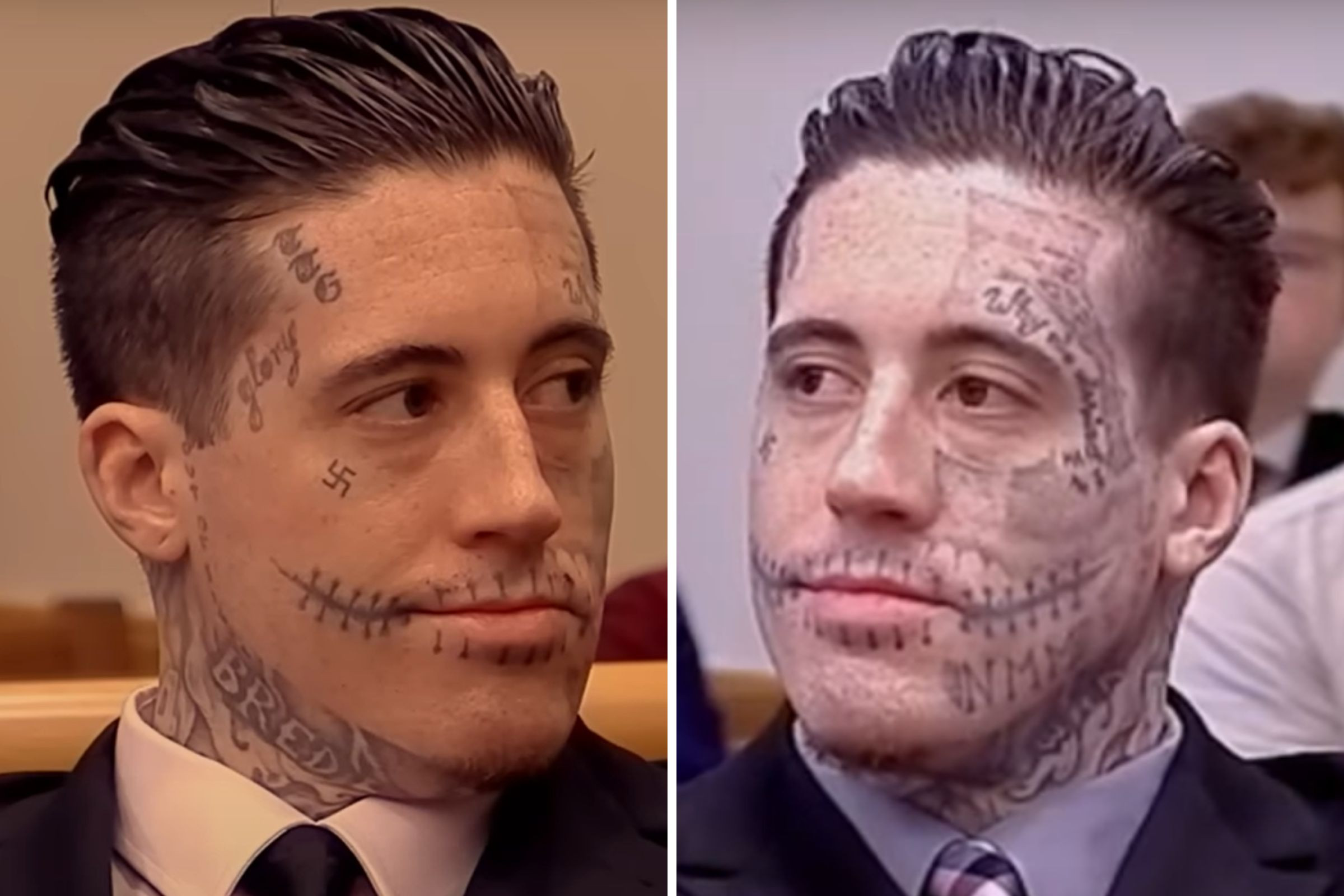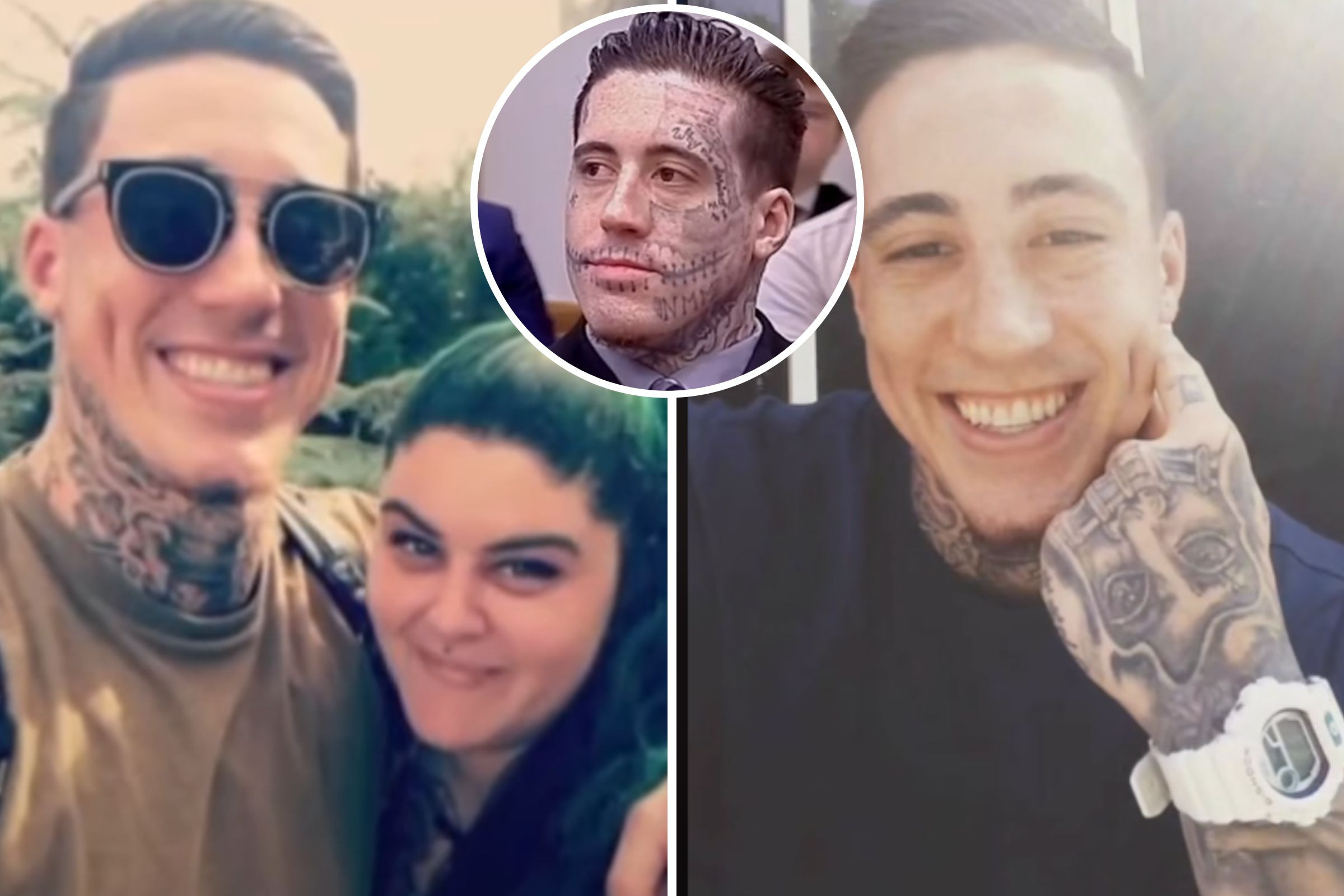When Did Wade Wilson Get Face Tattoos? Wade Wilson’s face tattoos are a chilling transformation that occurred after his arrest in October 2019, marking a disturbing shift in his appearance and public perception. Join us as we delve into the details behind this transformation, exploring the meanings behind the tattoos and the impact they had on his trial, all while guiding you to valuable resources on tattoo art and culture at tattooat.com, your ultimate destination for tattoo designs, inspiration, and expert guidance. Discover the perfect blend of art and knowledge with tattoo information, tattoo trends, and tattoo culture on tattooat.com.
1. Who is Wade Wilson?
Wade Wilson is a convicted murderer from Florida who gained notoriety not only for his crimes but also for the extensive and disturbing tattoos that cover his face, neck, and hands. This transformation occurred after his arrest in October 2019, leading to increased public attention and speculation about his motives and affiliations.
Wade Wilson’s Background
Before his arrest, Wade Wilson’s appearance was markedly different, as seen in older photos and videos. His clean-shaven face and lack of visible tattoos presented a contrasting image to the heavily tattooed individual who appeared in court. This transformation has prompted questions about his state of mind and potential motivations behind the body modifications.
Wade Wilson’s Crimes
Wade Wilson was convicted of the brutal murders of Kristine Melton and Diane Ruiz in October 2019. The horrific nature of these crimes, combined with his subsequent transformation, has made him a subject of intense public interest and scrutiny. According to court documents, the details of the murders are particularly disturbing, further contributing to the negative perception of Wilson.
2. What are the Meanings Behind Wade Wilson’s Tattoos?
Wade Wilson’s tattoos are not merely random designs; they carry specific and disturbing meanings, primarily associated with white supremacist ideology. These symbols have drawn condemnation from anti-hate organizations and added another layer of complexity to his public image.
White Supremacist Symbols
According to Anti-Defamation League Research Fellow Christopher Magyarics, many of Wilson’s tattoos are “blatantly white supremacist.” These include:
- The number 14: Representing the “14 words” white supremacist mantra: “We must secure the existence of our people and a future for white children.”
- The number 88: A numeric code for “Heil Hitler,” with 8 being the eighth letter of the alphabet (H).
- Swastikas: Prominent symbols of Nazi Germany and Adolf Hitler, displayed on his scalp and under his eye.
These symbols leave little doubt about Wilson’s affiliation with white supremacist ideologies.
Other Notable Tattoos
Besides the explicitly racist symbols, Wilson sports other tattoos with potentially violent or nihilistic connotations:
- TTG: Allegedly standing for “Time To Go” or “Trained To Go,” suggesting a readiness for violence.
- Bred for war: Inscribed under his chin, reinforcing the theme of aggression and readiness for conflict.
- Why so serious?: A reference to Heath Ledger’s Joker from “The Dark Knight,” along with “Ha ha ha” tattooed underneath, hinting at a chaotic and malevolent mindset.
- Stitched-on smile: Inspired by the Joker’s disfigured smile, adding to his menacing appearance.
- NMM: While the exact meaning is debated, some suggest it references Deadpool’s Wade Wilson, a dark joke about loss and transformation.
 wade wilson's white supremacist tattoos
wade wilson's white supremacist tattoos
Wade Wilson is seen in court. His tattoos feature white supremacist symbols, as confirmed by Anti-Defamation League Research Fellow Christopher Magyarics. Image Credit: YouTube/Law & Crime
3. When Did Wade Wilson Get His Face Tattoos?
Wade Wilson’s transformation occurred while he was in custody, awaiting trial for the murders he committed in October 2019. The tattoos, which significantly altered his appearance, were acquired sometime after his arrest and before his court appearances.
Timing of the Tattoo Acquisition
Old photos and mugshots taken at the time of Wilson’s arrest show him without the extensive facial tattoos that later became his defining feature. This indicates that the tattoos were obtained while he was incarcerated, a period during which he was presumably reflecting on his life and crimes.
Possible Motivations
The reasons behind Wilson’s decision to get these tattoos remain speculative. Some theories suggest:
- Affiliation: Aligning himself with a particular group or ideology for protection or status within the prison system.
- Intimidation: Creating a fearsome appearance to intimidate other inmates or exert dominance.
- Mental state: Reflecting a deteriorating mental state or a descent into extremist beliefs.
- Defiance: A form of rebellion or defiance against the legal system and societal norms.
4. What Was the Impact of Wade Wilson’s Tattoos on His Trial?
Wade Wilson’s appearance became a contentious issue during his trial, with discussions on whether his tattoos could unfairly prejudice the jury. The defense team explored options to cover them up, recognizing the potential impact on the jurors’ perceptions.
Attempts to Cover Up Tattoos
Wilson’s defense attorney, Kevin Shirley, acknowledged his client’s intimidating appearance and attempted to mitigate its impact on the jury. A motion was filed to allow Wilson to cover up his tattoos with makeup and get a haircut before the trial. The defense argued that the tattoos, including swastikas and other designs, could be objectionable to potential jurors and prejudice their judgment.
Challenges in Covering the Tattoos
Despite the motion being granted, the makeup provided was insufficient to fully conceal Wilson’s tattoos. This meant that the jury was still exposed to the visible symbols of hate and violence, raising concerns about the fairness of the trial.
Expert Opinions on Jury Impact
Richard Gabriel, president of Decision Analysis, Inc., commented on the potential impact of Wilson’s appearance on the jury. He noted that while tattoos are more widely accepted today, menacing-looking marks and swastikas could still have a subliminal effect on jurors, influencing their perception of whether Wilson looked like the kind of person who would commit the crimes he was accused of.
5. What is the Legal and Ethical Debate Surrounding Tattoos in Court?
The issue of Wade Wilson’s tattoos raises broader questions about the admissibility of appearance-based evidence in court and the balance between a defendant’s right to self-expression and the right to a fair trial.
Appearance as Evidence
In general, a defendant’s appearance is not considered direct evidence of guilt or innocence. However, it can subtly influence jurors’ perceptions and biases. This is particularly true when the appearance includes symbols or markings associated with hate groups or violent ideologies.
Right to a Fair Trial
The Sixth Amendment to the U.S. Constitution guarantees every defendant the right to a fair trial. This includes the right to an impartial jury that is not unduly influenced by external factors, such as prejudicial appearances.
Balancing Rights
Courts must balance the defendant’s right to express themselves (including through tattoos) with the need to ensure a fair trial. This often involves considering whether the tattoos are directly relevant to the case or are merely intended to prejudice the jury.
Precedents and Practices
In some cases, courts have allowed defendants to cover up tattoos or other markings if they are deemed unduly prejudicial. This practice acknowledges the potential for bias and aims to create a more level playing field for the defendant. However, the decision to allow or require such measures is made on a case-by-case basis.
6. What is the Significance of Wade Wilson’s Case in the Context of Tattoo Culture?
Wade Wilson’s case highlights the complex and sometimes controversial role of tattoos in society. While tattoos are often seen as a form of personal expression and art, they can also be associated with negative stereotypes or extremist ideologies.
Tattoos as Expression
Tattoos have a long and diverse history, serving as symbols of identity, status, and affiliation across various cultures. In modern Western society, they are often seen as a form of self-expression, allowing individuals to showcase their personality, beliefs, and experiences.
Tattoos and Stereotypes
Despite their growing acceptance, tattoos can still be associated with negative stereotypes, particularly when they are extensive, visible, or depict controversial imagery. These stereotypes can lead to discrimination in employment, social interactions, and legal proceedings.
Tattoos and Extremism
In some cases, tattoos are used to signify membership in extremist groups or adherence to hateful ideologies. These tattoos can serve as a visual marker of exclusion and division, reinforcing negative stereotypes and contributing to social tensions.
Responsibility and Choice
Wade Wilson’s case underscores the importance of considering the potential consequences of one’s choices regarding body modification. While individuals have the right to express themselves through tattoos, they must also be aware of the potential impact on how they are perceived and treated by others.
Wade Wilson’s mugshot shows him awaiting sentencing for the murders of Kristine Melton and Diane Ruiz. Image Credit: Lee County Sheriff’s Department
7. What are the Broader Implications of this Case for Criminal Justice?
Wade Wilson’s case raises important questions about the role of appearance in criminal justice, the potential for bias in jury decision-making, and the need for fair and impartial legal proceedings.
Objectivity vs. Perception
The criminal justice system is founded on the principle of objectivity, with decisions ideally based on facts and evidence rather than subjective perceptions. However, human biases and prejudices can inevitably influence the process, particularly when dealing with cases involving emotionally charged issues or visually striking defendants.
Need for Awareness
Judges, attorneys, and jurors must be aware of the potential for bias and take steps to mitigate its impact. This can include providing clear instructions to jurors, carefully screening potential jurors for prejudice, and taking measures to minimize the visibility of potentially prejudicial factors.
Focus on Evidence
Ultimately, the focus of any criminal trial should be on the evidence presented and its relevance to the charges against the defendant. While appearance may play a role in shaping perceptions, it should not be allowed to overshadow the facts or undermine the principles of justice.
8. Where Can You Find More Information About Tattoos and Tattoo Culture?
For those interested in learning more about tattoos, tattoo culture, and the broader world of body modification, there are numerous resources available online and in print. One excellent resource is tattooat.com, which offers a wealth of information on tattoo designs, artists, history, and trends.
Tattooat.com: Your Ultimate Tattoo Resource
Tattooat.com is a comprehensive online platform dedicated to all things tattoo-related. Whether you’re a seasoned tattoo enthusiast or a curious newcomer, you’ll find a wealth of information and inspiration to fuel your passion.
Extensive Design Gallery
Explore thousands of tattoo designs in various styles, themes, and placements. Find the perfect inspiration for your next tattoo or simply browse the gallery for artistic enjoyment.
Artist and Studio Directory
Discover talented tattoo artists and reputable studios in your area. Read reviews, view portfolios, and connect with artists who match your style and preferences.
Educational Articles
Learn about the history of tattoos, different tattooing techniques, aftercare instructions, and the latest trends in the industry. Stay informed and make educated decisions about your body art.
Community Forum
Connect with other tattoo enthusiasts, share your experiences, ask questions, and participate in discussions about all things tattoo-related.
Other Resources
In addition to tattooat.com, there are many other valuable resources available for learning about tattoos and tattoo culture:
- Books: Explore the rich history and cultural significance of tattoos through various books on the subject.
- Magazines: Stay up-to-date on the latest trends and techniques in the tattoo industry with magazines like Inked Magazine.
- Documentaries: Gain insights into the lives of tattoo artists and enthusiasts through documentaries about tattoo culture.
- Museums and Exhibitions: Visit museums and art galleries that feature tattoo art and exhibits.
- Tattoo Conventions: Attend tattoo conventions to meet artists, see live demonstrations, and immerse yourself in the world of tattooing.
9. How Can You Make Informed Decisions About Tattoos?
Getting a tattoo is a significant decision that should be approached with careful consideration and research. Here are some tips for making informed decisions about tattoos:
Research Designs and Styles
Take the time to explore different tattoo designs and styles to find something that truly resonates with you. Consider the meaning and symbolism behind different images and choose something that reflects your personality, beliefs, or experiences.
Choose a Reputable Artist and Studio
Research tattoo artists and studios in your area to find someone who is skilled, experienced, and reputable. Read reviews, view portfolios, and ensure that the studio follows strict hygiene and safety standards.
Understand the Process
Learn about the tattooing process, including the equipment used, the ink, and the steps involved in creating a tattoo. This will help you feel more prepared and comfortable during the procedure.
Consider Placement
Think carefully about where you want your tattoo to be placed on your body. Consider factors such as visibility, pain level, and potential for fading or distortion over time.
Prepare for Aftercare
Familiarize yourself with proper aftercare instructions to ensure that your tattoo heals properly and remains vibrant for years to come. Follow your artist’s recommendations and take good care of your skin.
Be Realistic
Understand that tattoos are permanent and that removal can be costly, painful, and may not fully restore your skin to its original condition. Be sure that you are making a decision that you will be happy with for the rest of your life.
10. What are Some Common Misconceptions About Tattoos?
Tattoos have been the subject of many myths and misconceptions over the years. Here are some common misconceptions and the truth behind them:
Misconception: Tattoos are Unprofessional
Truth: While tattoos may have been seen as unprofessional in the past, attitudes have changed significantly in recent years. Many workplaces now accept or even embrace tattoos as a form of self-expression. However, it’s important to consider the specific culture and policies of your workplace when deciding whether to get a tattoo.
Misconception: Tattoos are Painful
Truth: The level of pain experienced during a tattoo varies depending on the individual, the location of the tattoo, and the artist’s technique. Some areas of the body are more sensitive than others, and some people have a higher pain tolerance than others. However, most people describe the sensation as manageable and comparable to a mild stinging or scratching.
Misconception: Tattoos are Unsafe
Truth: Tattoos can be very safe when performed by a skilled artist in a clean and sterile environment. Reputable tattoo studios follow strict hygiene and safety standards to prevent infections and other complications. It’s important to do your research and choose a studio that prioritizes your health and safety.
Misconception: Tattoos are Only for Rebels
Truth: Tattoos are enjoyed by people from all walks of life, regardless of their age, gender, occupation, or social status. They are a form of self-expression that can be meaningful and empowering for anyone.
Misconception: Tattoos are Regretted Later in Life
Truth: While some people may regret getting a tattoo later in life, this is not the norm. Many people cherish their tattoos as reminders of important moments, people, or beliefs. The key is to choose a design that is meaningful to you and that you will be happy with for years to come.
 wade wilson and ex-girlfriend matthews
wade wilson and ex-girlfriend matthews
Wade Wilson is pictured with his ex-girlfriend Kelly Matthews. Wilson faces the possibility of the death penalty. Image Credit: Court TV/TikTok
FAQ About Wade Wilson and Face Tattoos
1. Why did Wade Wilson get face tattoos?
Wade Wilson acquired face tattoos while in custody awaiting trial for murder, with speculations ranging from aligning with prison gangs to expressing extremist ideologies.
2. What do Wade Wilson’s tattoos symbolize?
Many of Wilson’s tattoos are white supremacist symbols, including the numbers 14 and 88, along with swastikas, indicating adherence to hateful ideologies.
3. Did Wade Wilson have tattoos before his arrest?
No, Wade Wilson did not have the extensive facial tattoos seen in court appearances before his arrest in October 2019.
4. Were Wade Wilson’s tattoos covered during the trial?
An attempt was made to cover Wilson’s tattoos with makeup, but it proved insufficient, leaving jurors exposed to the visible symbols.
5. How did Wade Wilson’s tattoos affect the jury?
Experts suggest Wilson’s tattoos could have subliminally influenced the jury, potentially biasing their perception of him.
6. What is the legal stance on tattoos in courtrooms?
Courts balance a defendant’s right to self-expression with the right to a fair trial, sometimes allowing tattoos to be covered if deemed prejudicial.
7. Where can I find more information about tattoo culture?
Visit tattooat.com for extensive resources on tattoo designs, artists, history, and trends.
8. How can I choose a tattoo design that I won’t regret?
Research designs and styles that resonate with you, considering their meaning and symbolism, to ensure it reflects your personality or beliefs.
9. Are tattoos always a sign of rebellion?
No, tattoos are a form of self-expression enjoyed by people from all walks of life, not exclusively associated with rebellious individuals.
10. Is it safe to get a tattoo?
Tattoos are safe when performed by skilled artists in a clean and sterile environment, following strict hygiene and safety standards.
Wade Wilson’s journey from an ordinary individual to a notorious figure marked with hate is a stark reminder of the dark paths some people choose. His tattoos, acquired after his arrest, serve as a chilling testament to his descent into extremist ideologies.
Explore a brighter side of tattoo culture at tattooat.com, where you can discover stunning designs, connect with talented artists, and learn everything you need to know about this captivating art form. Whether you’re seeking inspiration for your first tattoo or expanding your knowledge of the craft, tattooat.com is your ultimate resource.
Ready to explore the world of tattoos? Visit tattooat.com today!
Address: 1825 SW Broadway, Portland, OR 97201, United States
Phone: +1 (503) 725-3000
Website: tattooat.com
